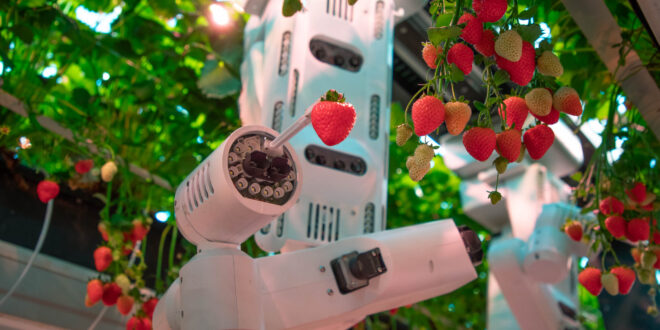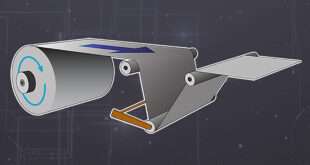Sasha Bruml and Felix Manley examine the supply of custom polymer components on demand to support the development and manufacture of their robotic harvesting systems
Dogtooth is a UK-based agri-robotics firm that is changing the fruit harvesting industry. The company is developing intelligent, autonomous robots designed to work alongside human farm workers, specifically to harvest soft fruits like strawberries and tomatoes. The company’s mission is to address critical labour shortages, reduce food waste, and increase efficiency in a sector vital to our food supply.
Dogtooth’s robots use state-of-the-art machine learning and computer vision technology to achieve the near-human levels of visual acuity and dexterity required to pick delicate berry fruits without damage.
Dogtooth’s robots are EVs that provide a complete alternative to human picking, and they can navigate autonomously along crop rows, find ripe fruits, pick dexterously and without damage, inspect and package picked fruit in situ, eliminating the need for repeated handling, and pick in cooler overnight conditions to increase shelf life.
The robot is made of many components sourced through a hybrid manufacturing strategy. While it uses standard, off-the-shelf parts where practical, its most innovative systems rely on custom solutions. This includes a combination of vacuum cast components for small-batch production and a significant number of 3D printed parts for the most complex, lightweight and rapidly-iterated components that form the core of the robot’s functionality.
3D People serves as a key manufacturing partner to Dogtooth Technologies, supplying custom polymer components on demand to support the development and manufacture of their robotic harvesting systems.
Using industrial powder bed fusion (PBF) 3D printing technologies like Selective Laser Sintering (SLS) and Muti Jet Fusion (MJF), supplies Dogtooth with both rapid development and production parts. Short lead times enable fast iterations using functional materials, ideal for real-world testing in evolving environments. Where appropriate, complex bespoke components are designed specifically for additive manufacturing and produced at scale, offering a reliable and cost-effective supply chain.
This partnership goes beyond simply 3D printing parts. By meeting Dogtooth’s engineers on-site, 3D People gained first-hand insight into the environmental challenges their robots face, the functional requirements of each subsystem and the bottlenecks that can arise in moving from prototype to production. This extra care allows us to deliver not just components, but practical, effective solutions that hold up in the field.
“We’ve been really pleased with 3D People’s responsiveness and willingness to adapt their processes to AgriTech’s specific needs, from ensuring smooth surfaces for cleanability to improving resistance to chemicals. That collaboration has helped us deliver a better product that meets user needs while balancing the complex demands of a high-tech application,” says Frank Tully, CTO Hardware at Dogtooth
Use of 3D printed parts
Dogtooth uses a range of 3D printed components across their robotic systems, from functional rapid prototypes to production parts deployed at scale. Below are four key examples of how AM supports different stages of their product development and deployment.
End Effector. The end effector handles the robot’s core task: cutting and collecting fruit. It is a clever assembly of both SLS and MJF parts designed to flex and pull a cutting rod, creating the precise motion needed to cleanly separate the fruit from the plant. The design leverages the natural flexibility of PA12 nylon when printed in thin sections to achieve a clean, controlled cut.
As it interacts directly with crops, this part needed to be developed around constantly evolving requirements, from differences in growing conditions to variations between plant types and fruit species. These complexities posed ongoing design challenges, which Dogtooth tackled by using 3D People’s industrial 3D printing service to produce functional prototypes.
Using PA12 Nylon material, the food-grade parts could be tested (quite literally) in the field, allowing fast iteration based on practical feedback. Additive manufacturing made it easy to adapt, test and iterate the End Effector in response to a steady stream of real-world insights, enabling its rapid development.
Lens Hoods. Dogtooth’s robots use an AI vision system that relies on cameras to capture the clear imagery needed to control the robot with precision. But out in the field, lenses are exposed to glare, dust and debris, which, understandably, can make it pretty hard to see.
The lens hoods are simple but essential components that shield the cameras from sunlight and environmental interference, helping maintain clear vision across all conditions, from dawn to dusk.
Produced by 3D People using MJF PA12 Nylon material, these parts are now deployed at scale across Dogtooth’s fleet. With a reliable 3D printing partner it is easy to produce robust, repeatable parts-on-demand, supporting fast, low-risk scaling as Dogtooth expands in the field.
Wiring Guides. Inside the robot arm, stereo image data travels through a tight, complex space and any disruption could impact performance. To keep things running smoothly, Dogtooth uses a set of bespoke internal components to route and protect the wiring loom.
These guides support the transmission of gigabits of image data from the arm’s cameras back to the central GPU, ensuring the system remains robust, reliable and easy to maintain. Their design is uniquely shaped to fit around the robot’s internal architecture, supporting a high level of dexterity without putting stress on the wiring.
3D People produces these parts in medium volumes using the MJF process, giving Dogtooth a cost-effective and flexible way to manufacture these complex bespoke components.
Arm Covers. Before committing to final tooling, Dogtooth used 3D People’s services to prototype new covers for the robot arm. These weren’t just visual mock-ups, they were fully functional components fitted to working robots, used to assess both performance and aesthetics in real-world settings.
By testing the covers with users and customers, Dogtooth was able to gather valuable feedback and refine the design to optimise both the look and feel of the machine. It also allowed them to check fit, usability and overall interaction before moving into volume production.
Additive manufacturing made it easy to bridge the gap between concept and production, giving Dogtooth the confidence to invest in tooling, knowing their design would perform as expected in the field.
The decision to integrate 3D printing into their manufacturing workflow was a strategic one for Dogtooth, driven by key advantages that directly address the challenges of developing advanced robotics. By choosing an additive approach with 3D People, they unlocked efficiency at every stage of their process.
Urgent Requirements Fulfilled with Unmatched Speed: For R&D, speed is paramount. When a field test reveals a potential improvement or a new sensor needs to be integrated, waiting weeks for a machined part is not an option. 3D printing allows Dogtooth’s engineers to go from a revised CAD model to a physical, field-ready component in a matter of days. This rapid iteration cycle means they can test more ideas, solve problems faster and accelerate their time to market.
Cost-Effective for Low Volumes of Custom Parts: Deploying small fleets of highly customised robots makes traditional manufacturing methods like injection moulding financially impractical due to high upfront tooling costs. For producing prototypes, jigs or end-use parts in low-to-medium volumes, 3D printing is significantly more economical. The cost function is simple: with no tooling costs to amortise, the price per part remains viable for any batch size, giving Dogtooth financial flexibility and control.
Simple Process and Minimal Design Constraints: 3D printing liberates engineers from the constraints of traditional manufacturing. The process is simple: design the optimal part, upload the file, have it produced. This freedom allows for the creation of highly complex geometries, internal channels and consolidated parts (like the wire guides) that would be difficult or impossible to produce otherwise. By removing manufacturing limitations, Dogtooth’s design process is streamlined, allowing their team to focus purely on function and innovation.
Summary
From rapid prototyping to production-ready parts, utilising the 3D printing services of 3D People gives Dogtooth the agility to build, test and scale at speed, without compromising on performance in the field. It is a partnership rooted in practical problem-solving, and one that continues to evolve alongside the robots themselves.
Sasha Bruml and Felix Manley are the Founders of 3D People.
 Engineer News Network The ultimate online news and information resource for today’s engineer
Engineer News Network The ultimate online news and information resource for today’s engineer


